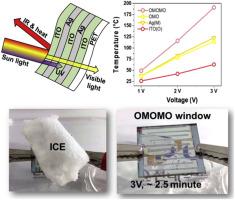Multi-channel transport with inter-digitated electrode-enabled flexible transparent heater for optical and thermal regulations
IF 4.6
3区 工程技术
Q2 ENGINEERING, ELECTRICAL & ELECTRONIC
引用次数: 0
Abstract
Transparent heaters have various energy applications, especially in buildings, with the advantage of low energy consumption, leading to energy-efficient heating. They can be integrated into structures and color-tuned for enhanced aesthetics. Herein, we designed transparent flexible heaters with various structures based on the Joule heating effect through multi-channel transport with inter-digitated-electrode (IDE), suitable for low-power utility with high performance. The approach to increase heat generation is decreasing resistance and increasing current at the same applied voltage. Multi-channel silver (Ag) metal-oxide composite generates heat through the Joule effect with high visible light transmittance and infrared reflectance. By depositing Ag on a transparent conducting oxide, it is possible to form electrodes that serve as a medium for efficient heat transfer. We evaluated each transparent heater structure's electrical and optical characteristics to assess their suitability for window applications. Comparatively, the oxide/metal/oxide/metal/oxide-IDE heater shows visible transmittance (69 %) and excellent IR-cutting (90 %) by tuning the light propagation. This transparent IDE structure with a size of 2.5 × 2.5 cm2 has sheet resistance (1.14 Ω/□) and rapid heating elevation (191 °C) at a bias of 3 V. This demonstrates that the functional design of electrodes can serve as energy-saving windows and selectively filter light propagation in useful ways.

多通道传输,数字化电极使能柔性透明加热器,用于光学和热调节
透明加热器有各种能源应用,特别是在建筑物中,具有低能耗的优势,导致节能采暖。它们可以集成到结构中,并通过调整颜色来增强美观。本文基于焦耳热效应设计了多种结构的透明柔性加热器,该加热器采用数字化电极(IDE)多通道传输,适用于低功耗、高性能的实用场合。增加发热量的方法是在施加电压相同的情况下减小电阻和增大电流。多通道银(Ag)金属氧化物复合材料通过焦耳效应发热,具有较高的可见光透过率和红外反射率。通过将银沉积在透明导电氧化物上,可以形成电极,作为有效传热的介质。我们评估了每个透明加热器结构的电气和光学特性,以评估它们对窗户应用的适用性。相比之下,氧化物/金属/氧化物/金属/氧化物- ide加热器通过调节光的传播,显示出良好的可见光透过率(69%)和红外切割(90%)。这种透明IDE结构的尺寸为2.5 × 2.5 cm2,具有片电阻(1.14 Ω/□)和快速加热高度(191°C),偏置为3 V。这表明电极的功能设计可以作为节能窗口,并以有用的方式选择性地过滤光传播。
本文章由计算机程序翻译,如有差异,请以英文原文为准。
求助全文
约1分钟内获得全文
求助全文
来源期刊

Materials Science in Semiconductor Processing
工程技术-材料科学:综合
CiteScore
8.00
自引率
4.90%
发文量
780
审稿时长
42 days
期刊介绍:
Materials Science in Semiconductor Processing provides a unique forum for the discussion of novel processing, applications and theoretical studies of functional materials and devices for (opto)electronics, sensors, detectors, biotechnology and green energy.
Each issue will aim to provide a snapshot of current insights, new achievements, breakthroughs and future trends in such diverse fields as microelectronics, energy conversion and storage, communications, biotechnology, (photo)catalysis, nano- and thin-film technology, hybrid and composite materials, chemical processing, vapor-phase deposition, device fabrication, and modelling, which are the backbone of advanced semiconductor processing and applications.
Coverage will include: advanced lithography for submicron devices; etching and related topics; ion implantation; damage evolution and related issues; plasma and thermal CVD; rapid thermal processing; advanced metallization and interconnect schemes; thin dielectric layers, oxidation; sol-gel processing; chemical bath and (electro)chemical deposition; compound semiconductor processing; new non-oxide materials and their applications; (macro)molecular and hybrid materials; molecular dynamics, ab-initio methods, Monte Carlo, etc.; new materials and processes for discrete and integrated circuits; magnetic materials and spintronics; heterostructures and quantum devices; engineering of the electrical and optical properties of semiconductors; crystal growth mechanisms; reliability, defect density, intrinsic impurities and defects.
 求助内容:
求助内容: 应助结果提醒方式:
应助结果提醒方式:


